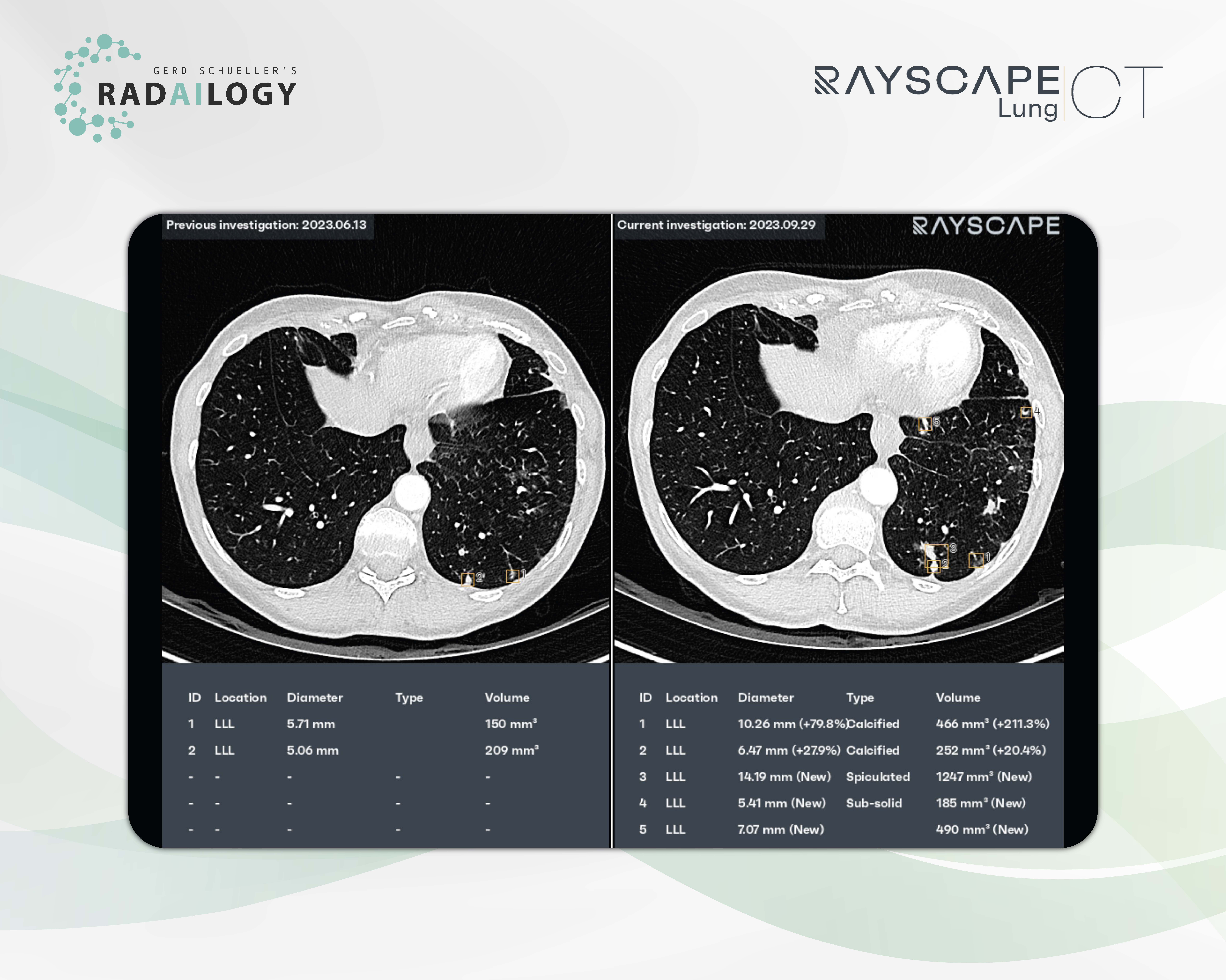Chest CT of a patient with a history of colorectal cancer. In the preliminary study dated June 13, 2023, two pulmonary nodules were visible in the left lower lobe (left). Rayscape Lung CT indicates the diameter and volume of each mass. In the follow-up CT dated September 29, 2023, these nodules progressed by 79.8% and 27.9%, respectively, in diameter and by 211.3% and 20.4%, respectively, in volume. In addition, three new nodules can be found in the lower lobe plane shown. Rayscape Lung CT marks these three lesions as new and indicates their diameter, volume and morphology (right).
Lung nodules occur in more than two million people per year in Europe alone. At the same time, the mortality rate from lung cancer worldwide is around two million annually. Their increase is expected to be around 30% in 10-year intervals. These few numbers alone illustrate the high level of responsibility that radiologists bear when interpreting computed tomography of the thorax. And the time-consuming nature of this task is particularly noticable when it comes to assessing lung nodules in each individual patient using their comparative studies.
It is with great pleasure that we present Rayscape Lung CT, an AI assistant for the detection of pulmonary nodules in CT studies.
Why Rayscape Lung CT matters and how it works
Rayscape Lung CT identifies pulmonary nodules from 3 to 30 mm in diameter. An important function is the automated comparison of nodules in the follow-up from CT study to CT study.
The results are reported in tabular form and visualized within the CT images. Each individual nodule is described with its exact location, diameter, volume and especially its morphology. These clear reports are an essential support for the transfer of knowledge from radiologists to patients and clinicians. Rayscape Lung CT can be used both for individual patients and in full-scale oncology departments.
Who benefits
Patients, clinicians and radiologists by the reliable detection of pulmonary nodules with clear reports in tables and images. In both screening and therapeutic oncology settings, the AI assistant with its precise analysis enables timely and individual treatment.
Our own experience at Radailogy
Rayscape Lung CT has high values for PPV, NPV and sensitivity of more than 97% each in our own patient population. At Radailogy, sensitivity in the correct detection of pulmonary nodules is over 93%. Nodules are precisely located and described using the parameters diameter, volume and morphology. If requested, up to three CT studies are compared in the follow-up setting. New nodules are reported as such. In particular, the automated comparison in follow-up lung CTs saves us an amazing amount of time for each individual patient every day and provides us with the desired additional security in the completeness of our findings.
Rayscape Lung CT performs a risk analysis for each study based on the established Fleischer criteria. We recognize this addition as useful, but we have not often used it in daily practice when discussing findings with clinicians and patients.
As described, the AI assistant detects lung nodules with high reliability. We found that primary tumors larger than 30 mm in diameter are not described in detail in the oncological follow-up. However, this is not the goal of the software formulated by the manufacturer.
The scientific evidence
Tenescu A, Bercean BA, Avramescu C, Marcu M. Averaging Model Weights Boosts Automated Lung Nodule Detection on Computed Tomography. 13th International Conference on Bioscience, Biochemistry and Bioinformatics. 2023 ISBN 978-1-4503-9819-0.
Benta MM, Rasadean C, Ardelean PG, Barbulescu I, Birhala A, Bercean B, Avramescu C, Tenescu A, Birsasteanu F. Artificial intelligence in computed tomography – lung nodule analysis algorithm. ECR 2022 DOI 10.26044/ecr2022/C-17388.
Data to upload to Radailogy
Native or contrast enhanced CT studies of the chest of any CT scanner age and vendor; axial reformations; maximal slice thickness 3 mm; lung reconstruction kernel; patient age at least 16 years

